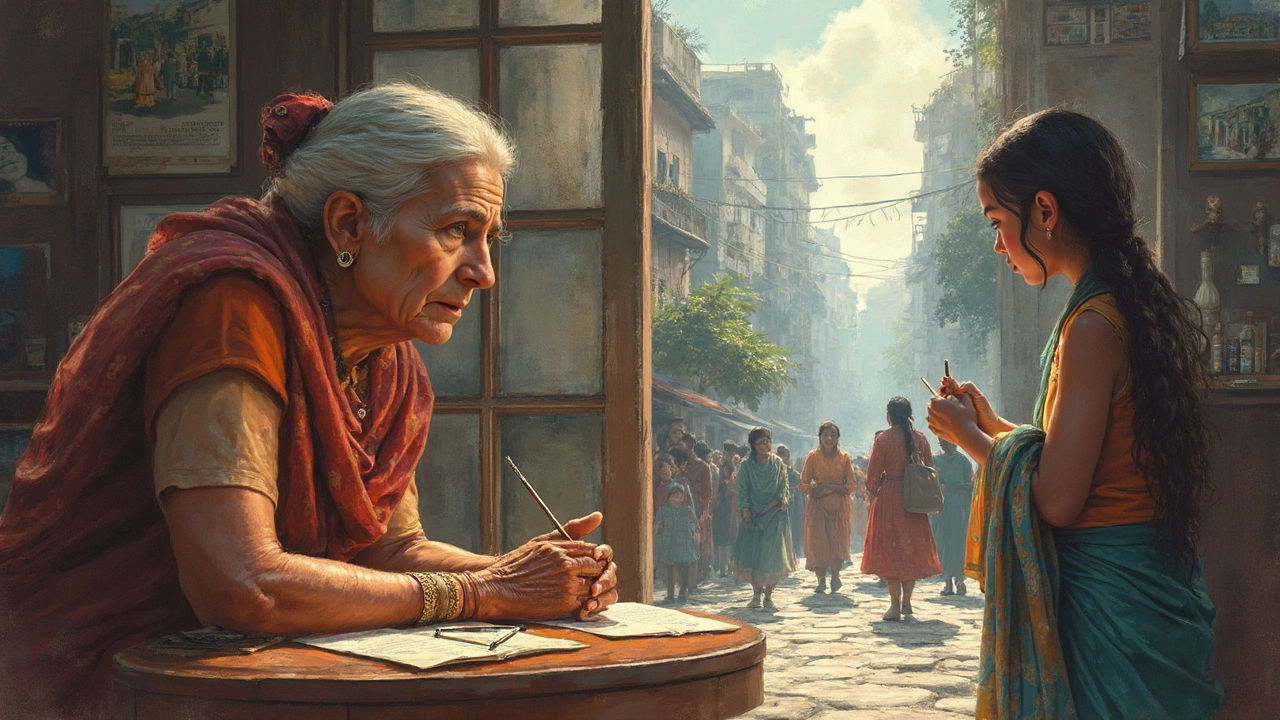Pick up two books about the past—one might be full of hard facts, while the other spices things up with imagined conversations and characters. That’s the difference between literary nonfiction and historical fiction, and it matters a lot if you care about what’s true and what’s made up.
Ever wondered if your favorite war story really happened, or if the writer just got creative? Knowing where the line is can save you from mixing up real history with a great piece of storytelling. Trust me, it’s easier to get confused than you think, especially when both genres are known for vivid scenes, real settings, and page-turning drama.
If you want to get better at spotting what’s real and what’s narrative magic, keep reading. Here’s what you need to look for when you’re scanning the shelves or flipping through that next big read.
- What Literary Nonfiction Really Means
- How Historical Fiction Plays with Facts
- Blurring the Line: Where Genres Overlap
- Tips for Telling Them Apart
What Literary Nonfiction Really Means
When people hear “literary nonfiction,” they might think it’s just another name for biography or history books, but it’s actually its own thing. At its core, literary nonfiction is all about telling true stories using the methods and style you usually see in novels. It’s often called creative nonfiction, and it covers anything from memoirs to essays and deep dives into real events. The catch? The events, characters, and settings must be real, no made-up stuff allowed.
Writers like Truman Capote really kicked off the whole movement. His book “In Cold Blood” from 1966 is famous because it reads like a thriller but sticks to the facts about a real crime. Or take Joan Didion’s essays—she reported what she actually saw and felt, but used scenes and dialogue that make it hit harder than your average news story.
If you look at how literary nonfiction works, here’s what you’ll usually find:
- The story is based on real people and real events
- Writers use actual documents, interviews, and their own experiences as sources
- Scenes feel vivid because of solid details, not imagination
- Dialogue and thoughts are drawn from records, not made up
- The voice and flow sound like a good novel, but don’t make things up
The best-known literary nonfiction goes beyond info-dumping—authors want you to feel, not just learn. They use tension, pacing, and sharp style, but stay true to what actually happened. You’ll see big names in this field, like Mary Karr (whose memoir “The Liars’ Club” changed the genre) and John Hersey (who wrote “Hiroshima” for The New Yorker using survivor accounts right after the atomic bomb dropped).
Check out these stats to see how literary nonfiction grabs readers’ attention, especially in the U.S.:
| Year | Nonfiction Market Share (%) | Memoir/Biography Share (%) |
|---|---|---|
| 2022 | 44 | 19 |
| 2023 | 43 | 18 |
The numbers show nonfiction isn’t just for textbooks—it takes up a huge chunk of what people want to read, and memoirs and true-life stories are a big slice of that pie. So the next time a book feels as gripping as a crime novel but claims it’s all true, you’re probably looking at a good case of literary nonfiction.
How Historical Fiction Plays with Facts
Historical fiction is the genre that loves to mix real events with a whole lot of imagination. Writers build stories around things that actually happened, but they often fill in the blanks with their own made-up characters, dialogs, and drama. This means you're getting a story that's partly true and partly from the author's head.
Take "All the Light We Cannot See" by Anthony Doerr as a great example. The bombing of Saint-Malo in World War II is 100% legit, but the main characters—Marie-Laure and Werner—never actually existed. The author uses facts as the foundation, but everything on top can be fiction. It's a similar story with "Wolf Hall" by Hilary Mantel, which sticks pretty close to Thomas Cromwell's rise in Tudor England, but gives Cromwell a voice and thoughts no one recorded back then.
So, what are the tricks writers use?
- Inventing personal stories for people who lived—or never even lived—at the time.
- Changing timelines or mashing two real events together to speed up the story.
- Adding small details, like fake diaries or letters, to make things feel more real (but these documents didn't really exist).
Readers love historical fiction because it makes the past feel close and dramatic. But don't get too comfortable—details like clothing, slang, or foods can sometimes be guesses. Even famous stories throw in a lot of creative license. For example, "The Book Thief" by Markus Zusak features Nazi Germany, but the main family and even the idea of Death as the narrator are straight from the author's imagination.
Here's a quick side-by-side with some real facts and how they're often used in historical fiction:
| Actual Historical Fact | How Fiction Uses It |
|---|---|
| The sinking of the Titanic (1912) | Main setting in the movie and novel, but characters like Jack and Rose are made up |
| French Revolution (1789-1799) | "Les Misérables" uses the revolution as background, but main characters are fictional |
| Battle of Gettysburg (1863) | Books may invent soldiers or families, slotting them into the real battle to tell a story |
The goal is to entertain and give a taste of how people might have felt—it's not about pure accuracy. That’s why, if you want hard facts, you should double-check the story's claims. But if you’re after an engaging read that explores the "what ifs," historical fiction is your best friend for mixing truth with a great story.

Blurring the Line: Where Genres Overlap
This is where things get tricky. Sometimes you find a book that feels like it’s straddling two worlds. You’ve probably heard of Truman Capote’s In Cold Blood. It’s a classic example that’s often called literary nonfiction (or creative nonfiction), but it reads like a suspenseful novel. Capote based every detail on the real 1959 murders in Kansas, but he also reconstructed conversations and gave us the inner thoughts of people—stuff he couldn’t have witnessed firsthand. Technically it’s nonfiction, but the storytelling style almost tricks you into thinking you’re reading a novel.
On the flip side, take something like Hilary Mantel’s Wolf Hall. It’s marketed as historical fiction because she dives into Thomas Cromwell’s world in 16th-century England, building scenes with real people and events. Still, Mantel fills in the gaps with imagined dialogue and motivations, since nobody has a transcript of what those folks said or thought. The result feels incredibly lifelike, but it’s not strict fact.
So how can you tell which is which? It comes down to how far the author goes with invention versus sticking to the records. Here’s a simple way to look at it:
- Literary nonfiction: The backbone is real events and facts. Any creative parts (like scenes or dialogue) are based on research, interviews, or documents as closely as possible.
- Historical fiction: The story might stick to known facts, but authors invent characters’ feelings, conversations, and sometimes even main events to fill out the gaps.
Let’s see a quick breakdown in numbers to show common practices:
| Genre | Invented Dialogue | Invented Main Events | Based on Primary Sources |
|---|---|---|---|
| Literary Nonfiction | Sometimes | Almost Never | Always |
| Historical Fiction | Always | Sometimes | Often |
There’s a gray area, for sure. Some books claim they’re “based on a true story” but play fast and loose with the facts. Others work so hard to stick to reality that you’d be amazed at how few lines are crossed. If you want the real deal, always check if an author explains what’s real in an introduction or endnote. That’s usually where they fess up to any creative liberties taken.
Tips for Telling Them Apart
Ever flip to the back of a book, searching for proof that what you just read really happened? You’re not alone. Here are simple ways to figure out if you’re holding literary nonfiction or historical fiction.
- Check the main character’s backstory: In literary nonfiction, you’ll usually find real people with names you might see in history books or news headlines. Historical fiction often brings in characters who never actually existed, or it puts real people in made-up situations.
- Look for author’s notes: Literary nonfiction writers are upfront about their source material. You’ll see notes, bibliographies, or even direct quotes from real interviews or documents. If you spot a disclaimer like “inspired by true events” or “a fictional account,” you’re probably reading historical fiction.
- Dig into the dialogue: Real conversations in literary nonfiction are pulled from records, interviews, or written accounts. If the talking feels too smooth or the scenes are packed with dramatic speeches nobody could have recorded, the author probably took creative license, which points to fiction.
- Notice the writing style: Both genres can be dramatic and detailed, but literary nonfiction sticks to facts. If you find dragons, time travel, or unlikely hero moments, that’s pure fiction territory.
Here’s a cheat sheet to make things easier:
| Clue | Literary Nonfiction | Historical Fiction |
|---|---|---|
| Main Characters | Real, documented people | Invented or altered for the story |
| Events | Stick closely to recorded facts | May twist or invent events for drama |
| Sources | Heavily referenced/cited, notes in back | Light on sources, often none listed |
| Dialogue | Based on real records | Often imagined |
| Purpose | Inform, explain real history or experience | Entertain, explore “what if?” |
Remember Erik Larson’s “The Devil in the White City”? It’s packed with direct quotes, footnotes, and well-documented references—that’s literary nonfiction. Contrast that with Hilary Mantel’s “Wolf Hall,” where even though Henry VIII is real, much of what goes on in his court is dramatized. That’s historical fiction done right.
If you ever feel stuck, scan the publisher’s page or the acknowledgments section. Most authors will spell it out for you. And hey, don’t sweat it if you can’t always tell right away—publishers sometimes blur the categories just to keep us guessing.

